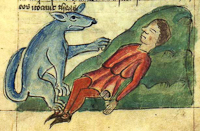| E-mail me at mcclainm@optonline.net | Visit my Facebook page | View my LinkedIn profile |

The concert, which consisted of twelve pieces based on texts from medieval bestiaries, was performed in the Fuentidueña Chapel by three members of Hesperus, a narrator and a mime.
The performers created a wild kingdom indeed, conjuring up mermaids, panthers, cranes and unicorns from the etymologies of Isidore of Seville, the music of the papal court at Avignon and the art of mime. The concert's setting was the stark Romanesque chapel at the Cloisters whose stone walls and high vaulted ceiling amplified every sound and whose sparse decorations – principally a fresco of the Virgin and Child and a crucifix hanging from the ceiling – reinforced the medieval tone.
The musicians – Tina Chancey, Grant Herreid and Tom Zajac – performed on early instruments: recorders, a lyre, a simple drum, and viols. They introduced the performance by introducing their instruments. Mr. Zajac told us that the recorder was invented to teach the birds to sing and Ms. Chancey was delighted to name the parts of animals that composed the drum's skin and the viol's strings.
Their performance by itself would have been worth the price of admission and the long trip into the city. Their playing was precise and expressive, evocative of medieval dances and liturgies. This is more or less what I expected, an hour-long concert of early music played by dedicated and talented artists. I was a bit surprised to learn that each piece would be accompanied by a reading from the text of a bestiary, those concoctions of description and folklore that interpreted the Book of Nature for medieval Muslims, Christians, and Jews. Owen Sandal's voice, however, fitted perfectly into the music, making it impossible to know if the music accompanied the reading or the reading accompanied the music.
I was even more surprised – and I confess a bit peeved – when I discovered that each of the pieces would also be mimed by Mark Jaster. I imagined that his performance would distract me from listening to the music that I came to hear. But as he variously became cat and mouse, horse and ape his ballet-like performance became the center of attention – or rather became one center of attention, along with the music, the narrative, the chapel and the sweet smell of the hyacinths blooming in a nearby cloister.
It was almost too much to take in, but because the performance was so well integrated my sensus communis, though challenged, was able to cope. Who would have expected that?